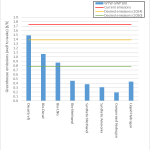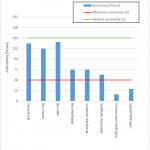Pushboat design considerations facing climate change
Pushboat operators, especially those operating on the rivers, face the transition to zero emission propulsion in combination with longer periods of low water. This results in conflicting design specifications. By combining different disciplines, MARIN is extending the scope of its design support to cope with this challenge.
In recent years low water levels along the Rhine have hindered navigation significantly. In parallel, operators need to switch to greener fuels. However, this means extra volume and/or weight is added for the energy storage and conversion. This is a major challenge given the dimensional constraints of these vessels.
MARIN investigated this subject studying two existing pushboats (40 m and 22.5 m), their operational profile and the minimum autonomy required (range without bunkering). By applying the Ship Power and Concept design tool a shortlist of possible energy carriers was deducted. Applying biodiesel and bioLNG reduces Green House Gas (GHG) emissions with available technologies, but less than required in 2030. Additionally, there are designs available for these fuels, which is why methanol was selected as the energy carrier in order to reduce GHG by more than 55%.
Alongside this, design optimisations were considered such as applying more and smaller propellers and optimising rudder profiles, which realised efficiency gains of up to about 10%.
Regarding the power train, the impact of two configurations was considered: applying a methanol/diesel dual fuel internal combustion engine (ICE) directly on the propeller shaft and the application of a dual fuel ICE generator set driving an electric engine on the shaft or on a thruster. In the latter configuration the efficiency reduces by applying more energy conversions, plus the weight of the engines might increase. In order to comply with the minimum draught of the 40 m pushboat (1.6 m for operating in low water conditions) the breadth increased from 15 m up to 18.5 m.
This concept design study focused on the development of viable concepts for future pushboat designs that meet the environmental challenges. With an optimised design, in combination with bioLNG, an overall well-towake GHG reduction of nearly 45% can be reached. In order to realise a bigger reduction bio-methanol, synthetic methanol and ammonia are promising. This requires further development of technologies and a clear roadmap with regard to the availability of these greener fuels along the waterways.



